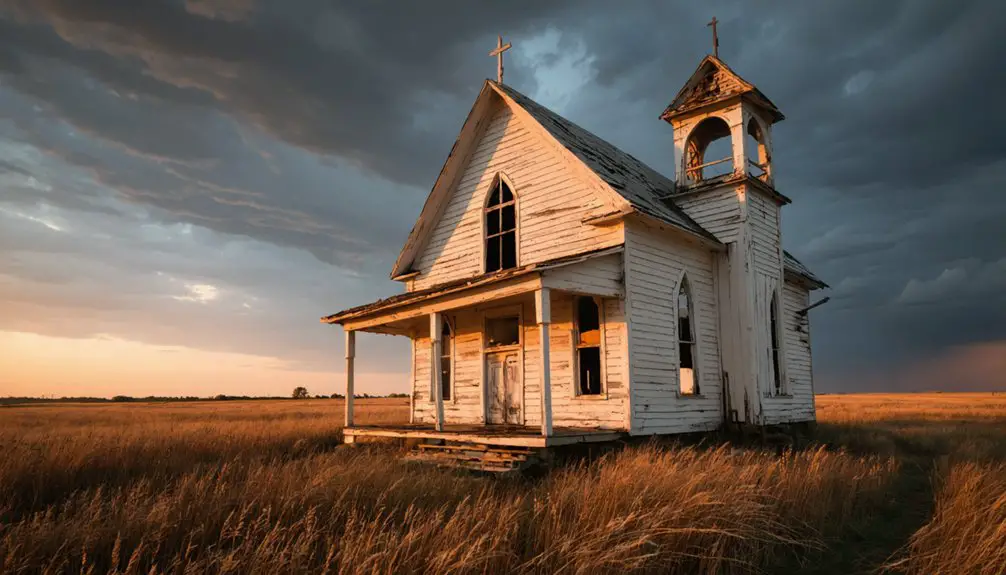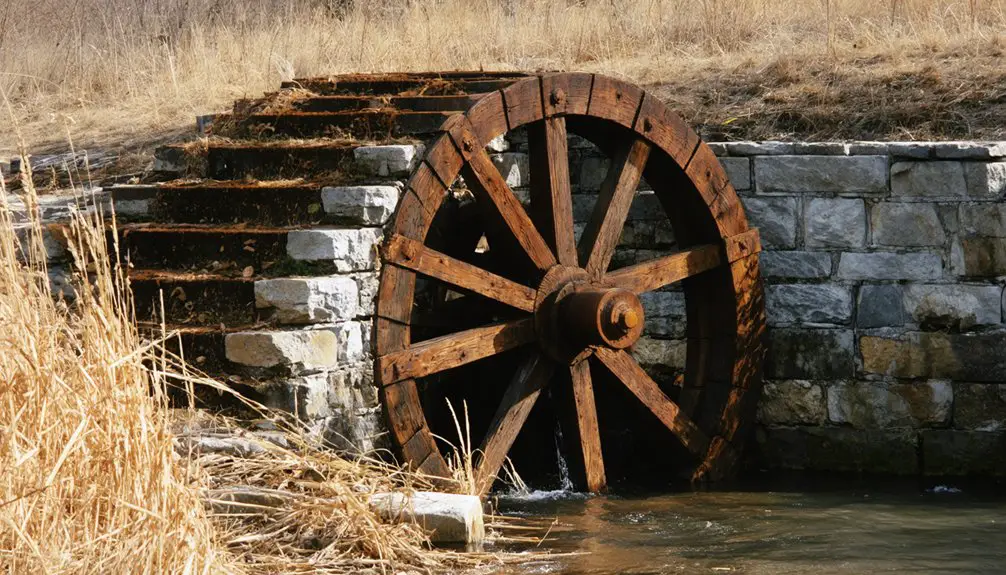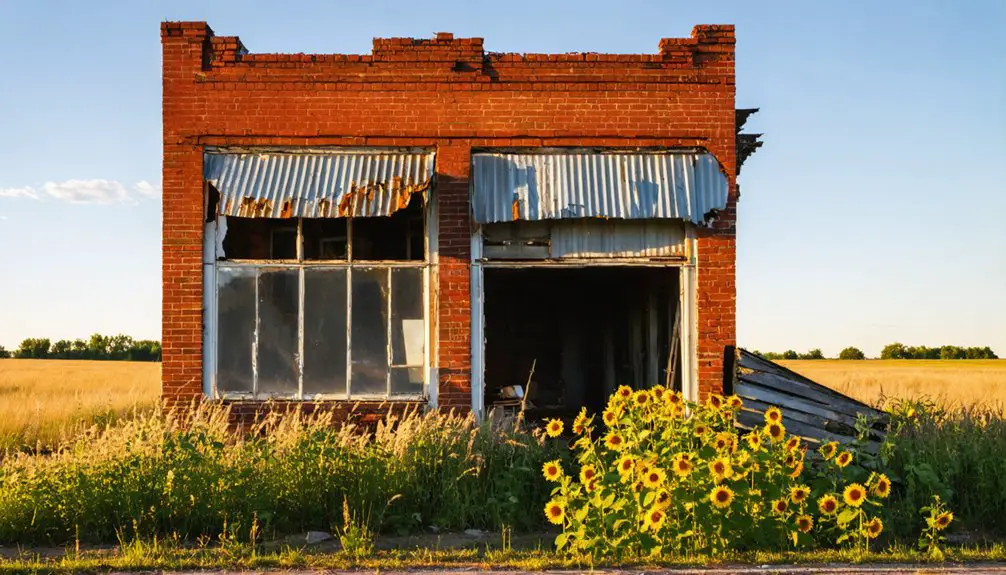You’ll find Millbrook’s ghost town ruins along the Solomon River in Graham County, Kansas, where a thriving frontier settlement of 3,300 once stood. Established in 1878, it served as the county seat until a devastating tornado struck in 1887, leading to its rapid decline. After losing political power to Hill City in 1888, Millbrook’s businesses shuttered and residents scattered. The abandoned townsite’s brick school and scattered structures tell a deeper story of frontier ambition and nature’s fury.
Key Takeaways
- Millbrook was established in 1878 as a frontier settlement in Smith County, Kansas, serving as Graham County’s seat until 1888.
- The town flourished from 1880-1887, growing from 75 to over 3,000 residents with a thriving commercial district and courthouse.
- A devastating tornado in 1887 triggered Millbrook’s decline, leading to the loss of county seat status to Hill City.
- The post office closed in 1889, followed by business closures and population decline throughout the early 1900s.
- Today, only deteriorating structures remain, including a brick high school, with nature reclaiming the abandoned townsite.
The Birth of a Frontier Settlement
While the Great Plains stretched endlessly across western Kansas, Millbrook emerged in 1878 as a determined frontier settlement in Smith County, positioned strategically near the confluence of the Solomon River and Spring Creek.
You’d have found fewer than 75 hardy souls in the area before 1876, as frontier challenges kept many away. The earliest settlers carved out their existence in dugouts, lacking traditional building materials on the open plains. They’d come seeking freedom through agricultural pursuits, joining a wave of westward expansion that included nearby communities like Hill City and the African-American settlement of Nicodemus. Like the early days of Oskaloosa Township, many struggled to establish permanent roots in these harsh frontier conditions.
Despite harsh conditions and minimal infrastructure, these pioneers persevered, though many couldn’t withstand the demanding environment and moved on between 1877 and 1880.
Early Days as County Seat
Following Millbrook’s designation as Graham County’s temporary seat in April 1880, you’ll find its political power solidified through two critical elections – first in June 1880 and again in July 1881.
Like many Kansas counties established during the territorial expansion, Graham County’s organization reflected the rapid development of local governance in the region.
The town’s decisive victory over Gettysburg in 1881, with 473 votes to 349, triggered significant population shifts as residents and businesses gravitated toward the confirmed county seat.
Your exploration of 1880s Millbrook would reveal a thriving frontier town that had successfully consolidated its administrative role in Graham County, drawing migrants from rival communities like Gettysburg. However, the town’s prominence was ultimately cut short when a devastating tornado hit on August 4, 1887, setting in motion its eventual decline.
Political Power Shift
As Graham County organized its first government in 1880, Millbrook emerged as a pivotal settlement when Governor John P. St. John named it the temporary county seat.
The town’s prominence was evident as N.C. Terrell built the first house and established a thriving general store in the growing community.
You’ll find that political alliances quickly formed as Millbrook faced challenges from Gettysburg, Hill City, and Roscoe for the coveted position.
Through two contentious elections in 1880 and 1881, Millbrook successfully defended its status, with residents even relocating from rival Gettysburg to strengthen its position.
However, the county’s political landscape dramatically shifted when a devastating tornado struck Millbrook in 1887.
During the subsequent county reorganization, Hill City seized the opportunity to challenge Millbrook’s weakened state. The arrival of the Union Pacific Railroad in 1888 further strengthened Hill City’s position as the new county seat.
Growth After Electoral Victory
Once Millbrook secured its county seat status in the June 1880 election, you’d witness the town’s rapid transformation into a bustling administrative center. Similar to how eight elections were needed to settle Wilson County’s seat, the path to Millbrook’s status was hard-fought.
The community growth accelerated when Millbrook clinched another decisive victory in July 1881, garnering 473 votes against Gettysburg’s 349. The electoral impact was immediate – most of Gettysburg’s residents relocated to Millbrook, further fueling its expansion.
You’d find a thriving town where N.C. Terrell’s general store anchored a growing commercial district.
The population surge throughout Graham County, which jumped from just 75 people in 1876 to 3,328 by 1882, supported Millbrook’s prominence. County commissioners and newly elected officials established administrative offices, while merchants and settlers built a robust community infrastructure around the seat of local government.
Political Rivalry With Neighboring Towns
You’ll find Millbrook’s most intense political struggles centered on its fierce competition with Gettysburg and Hill City for Graham County’s seat of power between 1880 and 1888.
After winning initial elections in 1880 and 1881, Millbrook held onto its county seat status until an 1887 tornado devastated the town’s infrastructure.
Hill City seized this opportunity to draw away Millbrook’s remaining population and secure the county seat in 1888, effectively ending Millbrook’s political influence in Graham County. Like many other settlements across Kansas, Millbrook’s decline followed a pattern of bad weather conditions that often doomed towns to become ghost towns. This pattern of decline mirrors towns like Riverdale, where only two homes remain occupied today.
County Seat Power Struggles
When Governor John P. St. John designated Millbrook as Graham County’s temporary county seat in April 1880, it sparked intense political maneuvering among rival towns.
You’ll find that Millbrook initially secured its position through two key elections – first in June 1880 against Gettysburg, Hill City, and Roscoe, then again in July 1881 when it defeated Gettysburg 473 to 349.
However, Millbrook’s grip on the county seat wouldn’t last forever.
After a devastating tornado struck in 1887, Hill City seized the opportunity to challenge Millbrook’s status. The March 1888 election shifted power to Hill City, aided by the arrival of the Union Pacific Railroad.
Population Migration Between Towns
Throughout the 1880s, population shifts between Millbrook and neighboring towns reflected intense political rivalries rather than just economic opportunity. You’d find migration trends heavily influenced by community rivalries as towns competed for dominance and resources in northwest Kansas.
While economic factors like land availability through the Homestead Act initially drew settlers from Pennsylvania, Ohio, Iowa, and Missouri, social dynamics and political influences soon shaped demographic shifts between communities. Similar to the chain migration patterns seen during the Great Migration, residents often followed family members and acquaintances when relocating between rival towns.
The region’s ethnic composition evolved as English, Scottish, Irish, German, and Scandinavian immigrants established roots. Town rivalries intensified as communities either welcomed or resisted certain migrant groups, affecting settlement patterns. With just four percent foreign-born residents, the area maintained a predominantly native-born population throughout these transitions.
Some residents would relocate based on a town’s perceived future viability and political power, creating a continuous flow of population changes that extended beyond simple economic considerations.
Life in 1880s Millbrook
Despite its modest beginnings as a homesteader’s settlement, Millbrook quickly emerged as Graham County’s administrative hub in the early 1880s after winning two contentious county seat elections.
If you’d lived in Millbrook during this time, you’d have found your daily commerce centered around N.C. Terrell’s general store, which served as both marketplace and meeting point.
Community activities revolved around the county courthouse, where you’d have witnessed the drama of local politics and administrative affairs unfold.
The county courthouse stood as a stage where citizens gathered to watch their local democracy play out in real time.
You’d have rubbed shoulders with newcomers from Gettysburg and other nearby settlements, all drawn by Millbrook’s growing prominence.
The town’s role as county seat meant you’d have encountered a steady stream of residents conducting official business, making Millbrook a bustling frontier democracy in action.
The Devastating Tornado of 1887
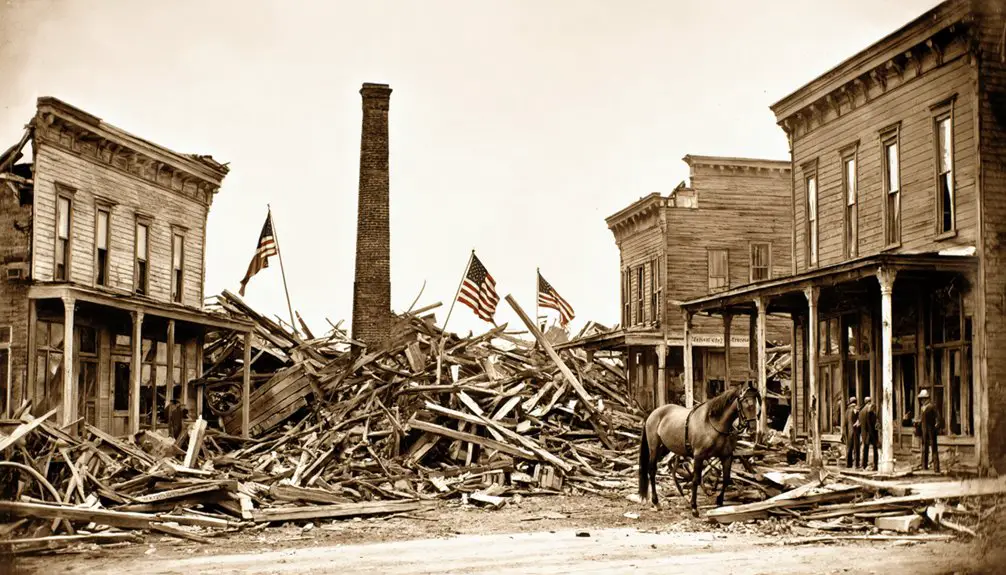
On August 4, 1887, a massive tornado ripped through Millbrook, Kansas, forever altering the town’s destiny. The twister’s devastating force left a trail of destruction, smashing homes against each other and scattering heavy timber debris across the landscape.
You’d have found victims blown into neighbors’ homes, while others lay trapped beneath wreckage until rescuers located them by their moans.
In the tornado aftermath, the community’s resilience showed through immediate rescue efforts, but the damage proved too severe to overcome.
Dave Wheeler suffered compound fractures and severe scalp wounds, representing just one of many tragic injuries.
By March 1888, Millbrook had lost its status as county seat to Hill City, marking the beginning of its decline into a ghost town.
The courthouse that once stood proud in Millbrook now exists only in memory.
Decline and Loss of County Seat Status
The political winds shifted rapidly after the 1887 tornado devastated Millbrook.
You’ll find that the town’s grip on its county seat status weakened considerably as the disaster crippled local infrastructure and scattered its population.
Hill City, just three miles northeast, seized this opportunity to challenge Millbrook’s administrative dominance.
In a decisive county seat election on March 6, 1888, Hill City emerged victorious over the struggling Millbrook.
The administrative decline continued as Millbrook’s post office closed in August 1889, marking the end of its governmental functions.
Final Days and Abandonment
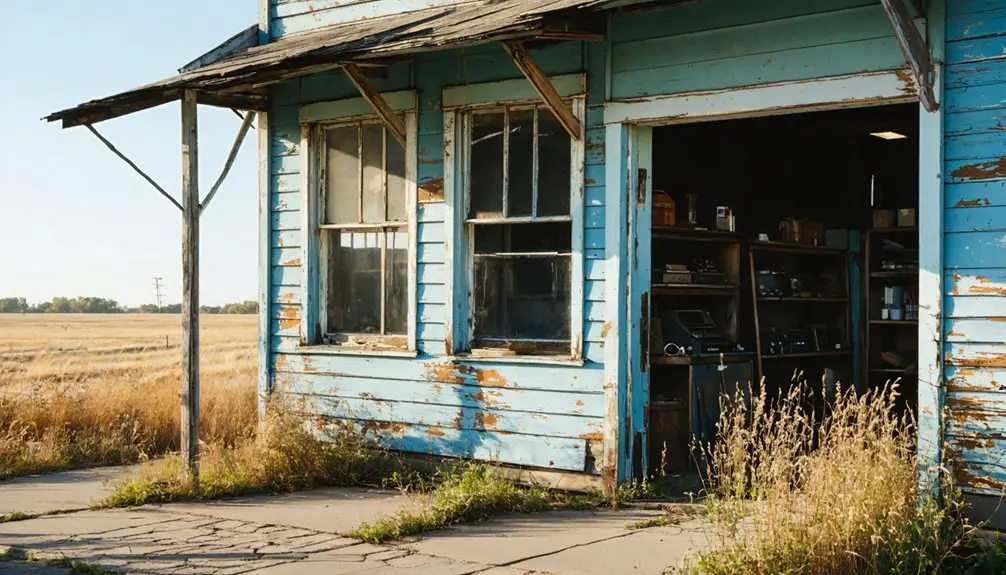
While Millbrook’s decline began with its loss of county seat status in 1888, its final descent into abandonment accelerated through the early 1900s as nearby coal mining operations ceased.
You’d have witnessed the final community struggles as businesses shuttered and essential services vanished, including the post office that had closed decades earlier in 1871.
The town’s gradual population decline became irreversible as devastating tornadoes repeatedly struck the region, destroying infrastructure and homes.
With no emergency services or resources for rebuilding, residents relocated to more stable communities like La Cygne and Parker.
The younger generation’s exodus to urban centers left Millbrook’s aging population dwindling.
Without maintained roads, active churches, or functioning schools, the town’s physical decay and social fragmentation ultimately led to complete abandonment.
What Remains Today
Today in Millbrook, you’ll find scattered remnants of what was once a thriving Kansas community, including a deteriorating brick high school building, ruins of a schoolhouse, and several dilapidated business structures.
Nature has steadily reclaimed the townsite, with overgrown vegetation covering old street layouts and abandoned structures slowly crumbling into the Kansas countryside.
Wild grasses and tangled vines swallow the ghostly remains of Millbrook, erasing streets and swallowing buildings into Kansas soil.
While you can still trace the former railroad lines and spot occasional street signs, the site now stands largely empty.
Historical artifacts from early 20th-century life lie scattered among debris in abandoned homes, and old utility poles dot the landscape.
You won’t find any active businesses or residents here – just the quiet whispers of the past amid decaying buildings.
Local farmers work the surrounding land, but the ghost town itself remains untouched, with no formal preservation efforts in place.
Legacy on the Kansas Plains
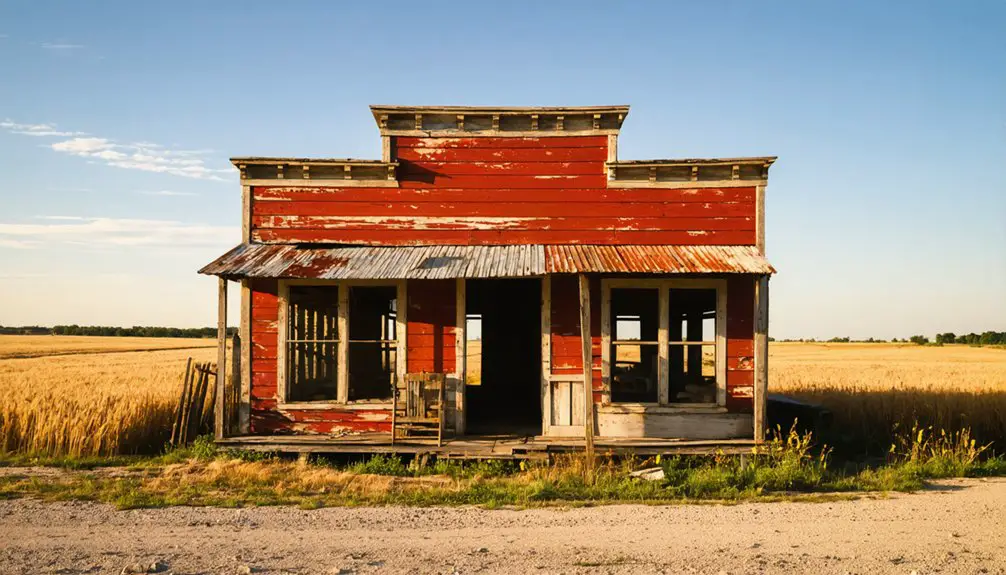
Standing as a demonstration to frontier ambition and fate, Millbrook’s rise and fall exemplifies the volatile nature of 19th-century Kansas settlement patterns.
You’ll find in its story the common threads that shaped many prairie communities – the fierce competition for county seat status, the impact of natural disasters, and the delicate balance of community resilience against frontier challenges.
Like many of its contemporaries, Millbrook’s destiny hinged on political decisions, railroad routes, and environmental forces.
When a devastating tornado struck in 1887, it triggered a chain of events that would transform the once-promising township into farmland.
Today, Millbrook’s legacy lives on as a reminder of how quickly fortunes could change on the Kansas plains, where survival often depended on factors beyond settlers’ control.
Frequently Asked Questions
What Did Millbrook Residents Do for Entertainment and Social Gatherings?
You’d find community events centered around the local hall and saloons, with church socials, dances, and outdoor gatherings shaping local traditions, while hunting and fishing provided regular entertainment.
Were There Any Notable Crimes or Lawlessness During Millbrook’s Existence?
Like a peaceful prairie breeze, you’d find few ripples in Millbrook’s calm. Historical records don’t show any notable crime incidents or law enforcement conflicts during its brief 1879-1895 existence.
How Much Did Typical Goods Cost at Terrell’s General Store?
You’d find local goods at Terrell’s priced affordably – flour at 5-10¢ per pound, coffee 10-15¢, candles 10¢ a pair, fabric 50¢-$1 per yard, and shoes around $2-3.50.
What Happened to the Tombstones and Graves From Millbrook’s Cemetery?
Peculiarly puzzling, you won’t find definitive details about the tombstone disappearance or cemetery preservation. While many ghost town cemeteries remain intact, historical records don’t reveal what happened to Millbrook’s graves after 1895.
Did Any Famous Personalities or Historical Figures Ever Visit Millbrook?
You won’t find records of any famous visitors in Millbrook’s brief history. The town’s limited historical significance as a temporary county seat didn’t attract notable personalities before its decline in 1887.
References
- https://www.youtube.com/watch?v=iB5rHT14eVI
- https://www.hhhistory.com/2019/05/ghost-towns-of-kansas.html
- https://fhsuguides.fhsu.edu/kansasheritage/grahamcounty
- https://www.youtube.com/watch?v=OyBXD18P_j4
- https://legendsofkansas.com/kansas-ghost-town-list/
- https://kgi.contentdm.oclc.org/digital/api/collection/p16884coll50/id/60/download
- https://krex.k-state.edu/server/api/core/bitstreams/38ec9051-5700-4d43-97de-0cb99996214d/content
- https://archive.org/download/conquestofsouthw00blan/conquestofsouthw00blan.pdf
- https://www.kancoll.org/books/cutler/jefferson/jefferson-co-p11.html
- https://www.hwy24.org/uploads/2/6/1/8/26189167/hillcity.pdf
